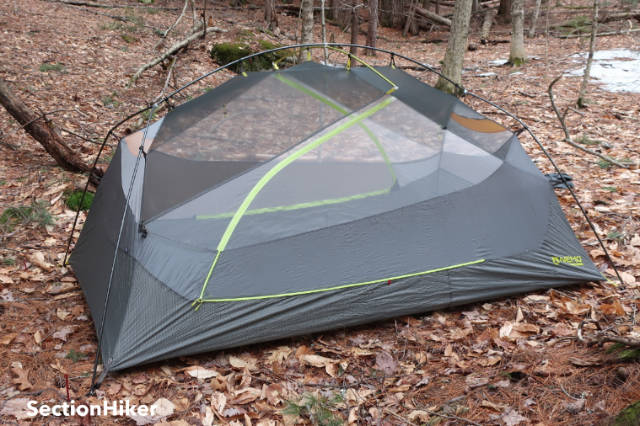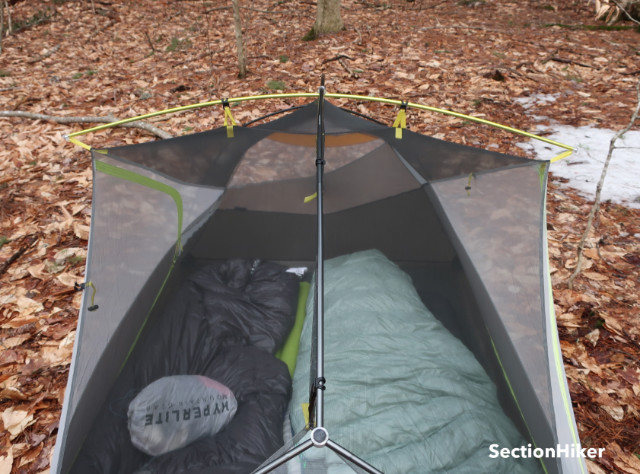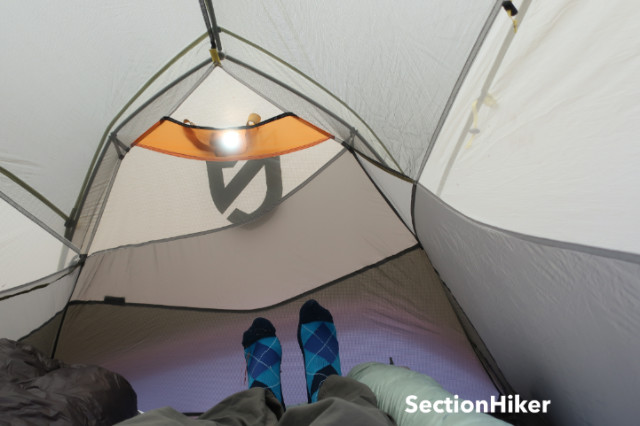The NEMO Dagger OSMO 2P Tent is a spacious freestanding double-wall tent for two people that is lightweight enough for backpacking but roomy enough for other camping adventures. Designed for two people, it has two doors and two vestibules, including 1 optional mini-mudroom called a landing zone to keep your gear dry on wet ground (you’d think they’d include two for both vestibules.) The tent is made with NEMO’s new OSMO polyester/nylon ripstop fabric which reduces rain fly sag when wet and improves waterproofing. The spacious interior and numerous livability accents make the Dagger OSMO 2P a great tent for tall people or couples that want more room to spread out.
Specs at a Glance
- Type: Freestanding
- Double-Wall: Yes
- Seasons: 3+
- People: 2
- Doors: 2
- Minimum Trail Weight: 3 lbs 2.8 oz (pole, inner, rainfly) – measured
- Packaged Weight: 4 lbs 0.3 oz
- Tent dry sack (1.4 oz) | Pole storage bag | 0.5 oz | Stakes, Cordage, Repair Sleeve, Sack (7.0) | Tent Pole: (16.4 oz) | Inner Tent (17.1 oz)| RainFly (17.3 oz) | Landing Zones x 1 (1.8 oz)
- Minimum number of takes to pitch: 4 (8 recommended)
- Seam taped: Yes
- Poles: 1
- Inner-tent dimensions: 90″ x 50″ x 42″ (L x W x H) – measured
- Interior (31.3 sq ft) | Vestibule (22.8 sq ft)
- Footprint: Sold separately (compatible with Dagger 2 footprint)
- Denier: Unpublished
- Hydrostatic head (waterproofing): Floor (2000 mm)
New OSMO Fabric

The tent is made with a new hybrid fabric called OSMO that NEMO created which is a composite weave of nylon and polyester that sags less when it gets wet compared to conventional tent fabrics made from nylon coated with polyurethane. Conventional nylon rain flies absorb water when they get wet from rain or dew and sag, which is why many tents look like shrunken prunes after it rains. In addition to flapping in wind, nylon rain flies sag onto the inner tent walls in a double-wall tent, exacerbating the internal condensation transfer which makes your gear wet inside. So by eliminating the sag, you experience less internal condensation transfer and your gear stays drier.
In addition to better performance in rain, the new OSMO fabric is made with 100% recycled nylon and polyester yarns and without the use of flame-retardant chemicals or fluorinated water repellents (PFAS). And unlike the NEMO’s past neon-colored “leaf” green tents, the OSMO fabric is a stealthy greyish-green that blends in well with natural terrain. The first time I pitched the Dagger OSMO 2 in the forest, I had a hard time finding it again after hiking away from my camp to hang a bear bag because it blended in so well!

Unfortunately, NEMO has opted to withhold some of the technical specifications of the new OSMO material such as the denier (a measure of thickness) of the floor and rainfly, although they have published the hydrostatic head (a measure of waterproofness) of the floor, which is 2000 mm. For both these reasons, we’d recommend using a footprint with this tent: the Dagger 2 footprint is compatible and sold separately
NEMO Dagger OSMO 2 Tent
Comfort
Ease of Setup
Weather Resistance
Durabilty
Weight
Packed Size
Spacious Freestanding Tent
Freestanding Tent Design
The NEMO Dagger OSMO 2P is a freestanding dome-style tent with a very spacious 90″ x 50″ inner tent floor that is wide enough for two wide sleeping pads, with lots of extra space at the head or foot ends for additional gear storage. There are many advantages to a freestanding tent design: it enables a rectangular floor plan and near-vertical walls, it’s easy for one person to set up, and can be set up on the ground, snow, or wooden tent platforms with ease.

The Dagger OSMO 2 comes with one multi-segmented tent pole that slots into four corner jakes feet connectors with an integrated cross-piece that creates vertical sidewalls for better livability. While the multi-segmented, dual-hubbed pole is somewhat bulky when packed, color coding eases setup while ensuring that you don’t lose a loose pole. segment.

Inner Tent
The inner tent has a bathtub floor and high sidewalls to prevent wind, dust, or rain from blowing under the rainfly walls and into the living compartment. The upper half of the inner tent is all mesh with white mesh sidewalls for privacy and a black mesh ceiling for insect-free star-gazing: the freestanding architecture also means you can use the inner tent alone on clear nights or you can roll back the rain fly cover and expose part of the ceiling for stargazing.

The inner tent has two doors so each occupant has their own entrance and exit. Each door has two zippers (one vertical and one horizontal) instead of one curved zipper. This design reduces tension on the zippers which can lead to zipper failure and makes it easy to open the doors one-handed. The screen doors can also be rolled back using gatekeeper clips which are easy to engage and release, unlike more conventional toggle and dowel door tie-backs.

There are mesh pockets in the corners of the inner tent but not on the head or foot ends, which I find rather limiting. There’s also no gear loft, although there are overhead loops where you can suspend items. However, there are headlamp pockets with light-diffusing fabric at both ends of the tent so you can create an ambient lighting effect at night. During the day, the interior is well lit even when the rain fly covers the inner tent and there is plenty of headroom to sit up inside if you want to hang out, read, or play cards with your tentmate.

Rain Fly and Vestibules
The setup of the rain fly is facilitated by color coding, so you don’t have to guess how to orient the vestibules with respect to the inner tent doors, which is an issue with many two-person tents. The corners clip into the jakes feet hardware used to set up the inner tent, so you still only need one tent stake for both, although in fair weather conditions the freestanding nature of the tent makes that optional (although you want to weigh down the interior enough so the tent doesn’t fly away in the wind). This is super handy when there’s snow on the ground and you don’t want to hassle with digging holes and freezing your tent stakes in them.

The vestibule doors, however, do require two stakes to set up, but there is a big benefit to the way they’re designed because you can leave the doors open without having to worry about which end of the tent is pointed into the wind. In addition, NEMO includes a “landing zone” (1.7 oz) with the tent, which is a triangular footprint that fits inside one side of the vestibule and provides a clean dry surface for you to place gear if the ground inside the vestibule is wet.

The landing zone is attached to the side of the inner tent and the underside of the vestibule with small plastic hooks. It is completely covered by the vestibule and does not get wet if it rains. This makes a nice place to store any item you want to keep off the wet ground, like a backpack, especially if it’s is not waterproof.
The vestibule doors have two-way zippers and a top kick-stand vent so you can unzip them from the top and prop them open for added ventilation. The vestibule doors can also be closed with velcro tabs positioned along the opening and rain gutters positioned along the door prevent you from becoming drenched if it’s raining and you need to exit the tent.

Comparable two-person backpacking tents
| Make / Model | Structural | Trail Weight |
|---|---|---|
| NEMO Dagger OSMO 2 | Freestanding | 3 lbs 2.8 oz / 1440g |
| Big Agnes Copper Spur HV UL2 | Freestanding | 2 lbs 11 oz / 1219g |
| MSR Hubba Hubba 2 | Freestanding | 2 lbs 14 oz / 1304g |
| Big Agnes Tiger Wall UL2 | Semi-Freestanding | 2 lbs 3 oz / 992g |
| NEMO DragonFly 2 | Freestanding | 2 lbs 9 oz / 1162g |
| Sea-to-Summit Telos TR2 | Freestanding | 3 lbs 4.3 oz / 1483g |
Recommendation
The NEMO Dagger 2 OSMO is a spacious and highly livable two-person, freestanding tent that has space for two wide sleeping pads in its interior. It’s made with a new composite nylon/polyester fabric that’s very low stretch when it rains and absorbs less water, dries faster, and helps reduce internal condensation transfer in a double-wall tent. While the internal storage pockets in the inner tent are somewhat lacking, the extra length (90″) and rectangular floorplan, landing zones, and huge vestibules offset most livability concerns, particularly for taller individuals who need a longer tent. Personally, my favorite feature on this tent are the large vestibules and the new muted color, which I find much more calming and stealthy for wilderness camping when you want to blend into the backcountry.
Disclosure: NEMO donated a tent for this review.
Compare 3 Prices
-

 Amazon US
Amazon US$529.95$479.00ViewAmazon.com Price: $479.00 (as of 04/25/2024 07:45 GMT-0400) Details
Product prices and availability are accurate as of the date/time indicated and are subject to change. Any price and availability information displayed on Amazon.com at the time of purchase will apply to the purchase of this product.
-

 Backcountry.com$529.95View
Backcountry.com$529.95View -
 REI$529.95View
REI$529.95View -

 Backcountry.com$529.95View
Backcountry.com$529.95View
 SectionHiker.com Backpacking Gear Reviews and FAQs
SectionHiker.com Backpacking Gear Reviews and FAQs 

Sounds like a nice tent. I HATE the name. We already have more than enough violence, actual and symbolic.
Not a big fan of the Buick La Sabre then either, eh?
If a simple name is enough to fill you with rage, I think that speaks more about you than the world on its own.
Any preference between this and the Slingfin Portal?
I think they’re designed for very different userss. The Dagger Osmo is a lightweight tent for couples who want to backpack. The thing is a palace. The Portal is designed for a more technical user who is pushing the envelope, camping above treeline in winds, etc. You don’t “hang out” or stargaze in the portal. You fall asleep exhausted.
Nice review on the tent. Would be a nice purchase if we didn’t buy a tiger wall last year.
What backpack are you using in those photos? Looks like an osprey but I can’t place the model.
It’s the new Osprey Exos 58. The one with hip belt pockets and an adjustable torso length.
Haha I was hoping that was the answer. I’m looking forward to the review?
Probably this week. :-) Just wrapping things up.
What are your thoughts between this and the new MSR Hubba Hubba 2.
I see the Nemo is a little heavier, but also a little longer. Prices are the same.
The Dagger OSMO is much larger – longer and with more vestibule space. The interior of the hubba hubba is much better though with a gear loft and better pockets, including wide ones underneath the end windows. Otherwise, they are both superb tents. If the size difference, weight, and pocket organization differences don’t matter, I think it boils down to your vestibule preferences. For example, I almost always sleep with the vestibule doors open and I like the Dagger vestibules better because they protect me from the wind on both sides. If I always kept the vestibule doors closed at night, I’d probably go with the Hubba Hubba.
Thanks, I’ll give it more thought, but I think I’m still leaning towards the MSR.
Thank you for the great review. I would like to make one correction to your review for accuracy. The Nemo Dagger Osmo 2P comes with only one (1) landing zone, and not two as described in your review. There are attachment points on both entry sides of the tent, so you have the option to set it up on either side, but the tents are sold with only one landing zone, and currently there isn’t an option to purchase this part separately.
I confirmed this directly with Nemo’s customer support. I think that it is silly that they do not provide two landing zones since this is a 2 person tent. Considering the high-end price of this tent, IMO it should include two landing zones, the loft (which is an option sold separately) and the footprint (also sold separately).
I think that the fact that the donated tent that Nemo provided to you came with two landing zones is an indication that even they recognize that this is a desirable setup.
Thanks,
CR
Actually, the tent NEMO sent me to review had been used by another reviewer before me and only included one landing zone. I incorrectly assumed that the other reviewer has forgotten to pack the second landing zone (there was also a missing tent stake and other ephemera) and just assumed two were included since there are places to attach them on both sides of the tent. It’s just stupid to only include one. Meant to check on that with NEMO but it slipped my mind.
Any guess on which (Hubba v NEMO) will be more durable? Fabric, plastic, fittings, etc.? How thick/buff does the new NEMO fabric feel?
I think they’re both 20d, even though Nemo doesn’t publish the denier (measure of thickness). Quite honestly, they’re both very durable but I’d opt for the MSR simply because they build sturdier shelters. NEMO’s not bad, but I don’t think they’re not quite as focused on the durability dimension as MSR is and I’ve used a lot (almost all) of both brands’ tents and shelters.
Just a question on setup. I recently purchased this tent. Is the neon yellow section of the pole that attaches to the center of the tent supposed to go over or under the main tent poles going to the 4 corners? In your pictures the pole goes under but in the directions and other reviews it goes over the top. I noticed this because I myself had to double check during setup. It definitely made a difference for myself when putting on the fly. Thank you for your insight.
I’ve set it up both ways, with the green pole on top and on the bottom and don’t think it matters that much since the green pole is under lots of tension either way, but if you look at NEMO’s tent setup video https://youtu.be/YfQ8ma0NSw0 they have the green rod on top.
Its a well designed tent. Its not a 3 plus if you live in Alaska, which I do. It withstood normal wind, it had very small, delicate vents I wish were made better, it did not feel really flimsy like the Big Agnes-it was worth the extra pound, it is a good idea to get the footprint because once the floor gets a puncture any tent in a damp area is a nightmare.
Too small for two people. My mat is 25 inches across (I roll around a lot) and it takes up most of the floor. Yo would need to be two people who were very, very small to fit here. I weigh just under 140 pounds and the tent seemed like a one and a half person tent. Like one person and a book sized tent.
I love the color, it allows stealth camping or blending in with nature in non desert areas. Its tastetful and doesn’t scream “I am here!”. I do not like the new grommets for the tent poles at all. They look like something from a LEGO kit.
It is quite waterproof even though the fly does not cover the entire tent. You also have 2 tiny pockets on opposite walls that are large enough for a cell phone or a compass.
Those corner grommets are called jakes feet (foot). They let you use one stake for the fly and the inner tent. They’re good because they’re easy for people to figure out.
Your reviews are really helpful. For people like me who don’t have much experience in it, they take you further
Glad that comes through.
Just wondering why the fly is missing some coverage on the bottom sides in an offset design?.. I figured that it might allow more air in but wonder if it would be a leakage point in a heavy rain. We usually use a small tarp over out tent as well but ? It seems odd! We also are dissapointed that the ground sheet doesn’t go under both the vestibules. I didn’t purchase one for this reason… If I have to add fabric to the deficient grounds sheet, I might as well make my own groundsheet!
Thanks… Heather
Nice review, there is a lot to like about this tent, unfortunately we seem to have gotten one with really poor quality zippers which started separating 1 week into a 6 month trip to South America. After a few weeks of frigging around, we have learned to only squeeze the rear end of the zipper pull with pliers… to get the teeth to engage again. Hopefully this info will help someone else, but we are at the point trying to purchase a new tent.
I suggest you contact the manufacturer and get a replacement. But then again, that is how you fix a zipper.
I am very frustrated with my dagger Osmo zippers too. I have had it less than a year and a half and one sides broke, and the other is jammed. I have had over a dozen tents in 50 years of backpacking and never had these issues. Good luck to other dagger users.